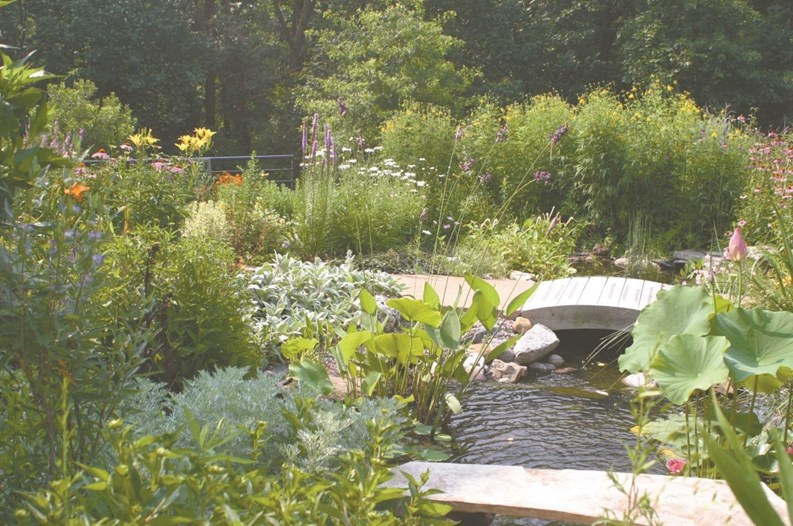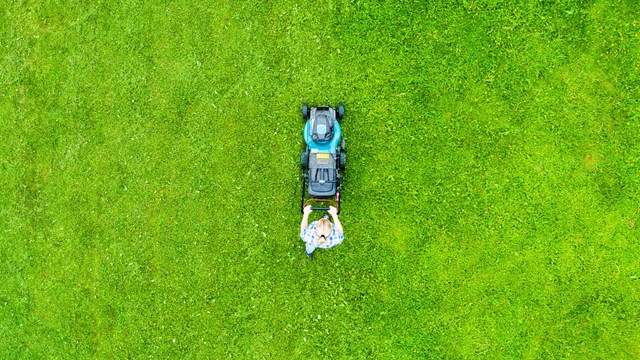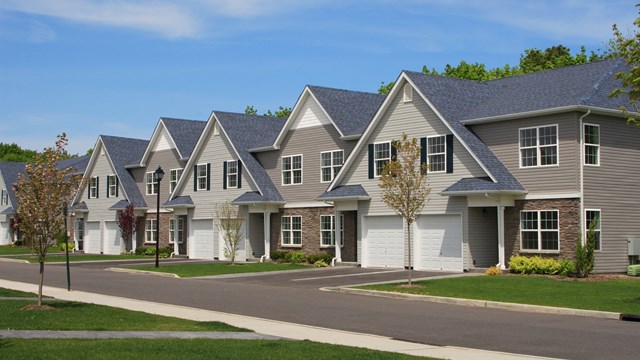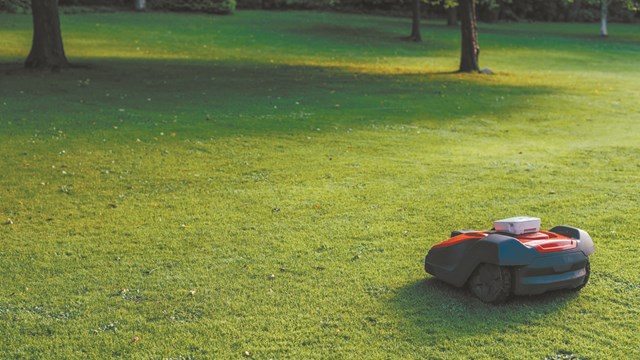In the realms of resource management and environmental concerns, coal, oil, and carbon dioxide get a lot of press—yet water is one of our most precious, most wasted, and least talked about commodities. One of the biggest culprits when it comes to wasted water is lawn care—grass requires a great deal of moisture to look its best, and irrigation, sprinkler systems and hose-watering all use a tremendous amount of water.
There are alternatives to turf, however—landscaping formats that use less water, but that can be as attractive, or even more so, than plain grass. Rain gardens and xeriscapes are two such solutions, and in addition to helping to provide some relief to the environment, their installation can make a landscape unique and beautiful.
Basic Concepts
A rain garden is a shallow depression planted with native perennial plants designed to catch and absorb rainwater as it runs off higher elevations. The absorption significantly reduces the erosion, water pollution, and flooding that can accompany runoff from impervious surfaces like roofs, sidewalks, parking lots, and hard-packed ground.
“Rain gardens help create a more sustainable landscape,” says John Senn, spokesperson for the EPA’s Region 2 office in New York. “Planting and maintaining rain gardens, especially those that feature native plants, help with storm water management. They also help create a more natural environment.”
“We are talking to people about keeping the rain water that falls on their property on their property, as opposed to letting it wash into gutters and sewer systems,” says Sue Cubberly, from the Rain Garden Network in Chicago. “And a great way to do that is through a rain garden.”
There are several means and reasons for directing the flow of rainwater, continues Cubberly. “The process involves directing water through downspouts and driveways into the garden, which is planted with deep-rooted native plants that grow well in the area without municipal water. Rain gardens hold that water in a shallow depression for a short period of time, and allow the water to slowly sink into the ground.”
This accomplishes a number of things: it replenishes the plants, keeps water from going into the sewer system, and eventually allows the water to seep into the groundwater, replenishing the aquifers, which supply many municipal water systems.
Water Quality, Water Quantity
After a rainfall—even a relatively small one—water that falls on concrete and asphalt rushes at a much greater rate into streams and rivers. “It is very abnormal for rivers to accept these large quantities of water as quickly as they do now,” says Cubberly. “In the natural system, when water falls, it’s soaked into the ground. It doesn’t run off site from all of these impervious surfaces. The rush of storm water is causing some of the major flooding that we are experiencing.”
“Water also picks up small but significant quantities of pollution,” explains Cubberly, “whether it’s from cars (from oils, brake dust, metals), pesticides, herbicides, or animal waste. So the idea is to deal with this pollution on the small scale so that it doesn’t combine with other small scale runoff, becoming a much larger collection of pollutants, which is then a major problem for the environment and the larger water cycle.”
Rain gardens are useful in rural, urban and suburban areas, says Cubberly. “I’ve seen a lot of rural areas using rain gardens, but…they use them for different pollutants, like fertilizers. We are trying to focus on more urban and suburban areas where there is so much concrete and asphalt in order to deal with the little bits of consumer pollution most of us put down everyday.”
Rain gardens may work in all types of areas, but they can’t be put just anywhere. Rooftops, for example, are not appropriate locations for rain gardens [although they are great for green roofs -ed.] Green roofs don’t replenish groundwater, but they can absorb an inch of rain or more. Combining green roof innovation with a rain garden strategy can have a significant impact on erosion and runoff.
When it comes to implementing a rain garden system, “Suburban locations are easier to use because they have the space for installation,” says Achva Benzinberg Stein, director of the City College Architecture Center (CCAC), and the director the graduate program of Landscape Architecture at City College in New York City. “Urban areas are space-challenged in general and the competition for a space’s use is often very high.”
“City perimeters and suburbs end up having more available space for rain garden installation,” agrees Cubberly. “In inner cities, it might be harder to develop property for this purpose. A lot of it has to do with the personal ability to dig into the ground.”
Other Benefits and Challenges
Rain gardens have other benefits too, says Cubberly. “Any time you plant nice-looking plants…property values tend to respond positively. It gives color to the neighborhood—more than just the emerald green of turf. It also creates habitat for beneficial insects like bees and butterflies.”
“Also,” Stein adds, “children can get involved in the maintenance if their school plants or adopts a rain garden, for example.” Getting kids involved in the environment will give them greater access to nature and a connection to their physical setting. “Additionally, rain gardens can be temporary solutions, leaving open the opportunity to build over them with relative ease compared to other constructed solutions like manholes or pipes.”
Rain garden installation has three major concerns: how big the garden itself should be, where it should be installed, and what to do with the excavated soil. The size of the garden should reflect the amount of water that it will be handling, and there are calculations to help determine the appropriate size. The location of the garden should be dictated by the flow of the water on the site. The soil that is removed can be used to fortify existing foundations or hauled to another location to be used as topsoil or landscape filler.
Plants are another key consideration. Your landscaper can help you choose species that are appropriate for your HOA’s climate and elevation, and can incorporate native species and grasses into the design. A good landscape planner can also work with the color and blooming times of plants to make sure your association’s rain garden is attractive and flourishing for the better part of the year.
Xeriscapes
Another landscape solution is xeriscaping, which approaches the water issue from a scarcity perspective. The term “xeriscaping” incorporates the Greek word “xeros,” meaning “dry,” and was coined to describe landscaping and gardening strategies that require very little water—or no water at all, in some cases. The trend started primarily in areas with little rainfall or other natural water supply, but also has potential for communities with limited budgets, or who are looking for an interesting alternative to the usual shrubs ‘n’ bushes approach.
“Water is an issue all over the world, not just in desert areas like the American West,” says Stein, who wrote the guidelines for xeriscaping for the city of Los Angeles. “Even in tropical areas, sediment and flooding greatly affect the amount of useable clean water. When you have water, you don’t tend to look for solutions to these problems.”
While planting for a scarcity of water may call up images of barren deserts or even the moon, xeriscaping is a much broader term that incorporates many strategies, including the movement toward the use of native species over non-native, often invasive, plant varieties. Native species are more adapted to the environmental fluctuations and general climate of any given area, and therefore are more likely to thrive on the amount of available water, without becoming invasive, since they have evolved alongside their natural checks.
“One of the best ways to participate in xeriscaping is to select native plants that are appropriate to the environment,” says Stein. She points out that the idea of a gently sloping, manicured lawn comes from a certain cultural heritage that is not indigenous to North America, and isn’t actually a sustainable land practice here. Most people are attracted to turf is because it embodies the idea of land ownership, but other landscaping options can be equally compelling, yet require much less water, pesticide, fertilizer, and maintenance.
“We need to change our attitude toward what is beautiful,” says Stein. “The problem with many landscape installations is that they require a great deal of irrigation in order to maintain them, which means that clean water is used for that purpose instead of for drinking.”
For HOAs interested in xeriscaping, it may be challenging to find a nursery that specializes in native plants and a designer who is well-versed in xeriscape practices, but going to a local agricultural extension office can often provide expertise and contact information for appropriate nurserymen. Local university extension offices and nurseries interested in getting involved with rain garden projects can be found at www.raingardennetwork.com, or at the EPA’s greenscaping website at www.epa.gov/region2/greenscaping.
It’s also worth noting that many professions have a stake in rain garden and xeriscape installations, including contractors, landscape architects, biologists, and ecologists, to name just a few—so greenscaping projects benefit more than just the associations they go into: they help the economy too.
Not Just for Tree-Huggers
While alternative landscape solutions such as rain gardens and xeriscapes may seem like something for folks who compost religiously and turn their entire backyards into terraced organic farmsteads, it’s not just for the environmentally super-conscious anymore. As natural resources dwindle, more and more states (including California and Florida), are already legislating xeriscaping technologies for their large public projects, and more states are sure to follow.
Where there is opportunity, larger water management solutions provide even greater benefits, says Stein. “Constructed wetlands, for example, not only deal with storm water management and surface runoff, but can bioremediate the water in more significant ways, since is has time to allow the bacteria and beneficial organisms to filter the water as it moves slowly through the natural or constructed system.”
And although many of these technologies may seem like new advances, this is really a new permutation of an old idea, says Stein. “We have known for a while that any time you take surface water and send it through a purification, it benefits the natural system. Dry wells have been popular for many years, and that is a fairly old solution.”
“People need to educate themselves so that they can better communicate their desires to any landscape architect or contractor,” continues Stein. “New techniques are constantly emerging, and the field is experiencing ongoing changes, so consumers should look for a professional who specializes in the kind of installation that they would like to pursue.”
Denton Tarver is a freelance writer and landscape architect-in-training. He lives in New York City and is a regular contributor to The New Jersey Cooperator.










Leave a Comment